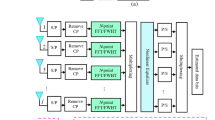Abstract
This paper proposes a novel scheme to transmit signals in a downlink multiuser multiple input-multiple output scenario. The proposed scheme combines spatial shift keying modulation and orthogonal Walsh codes. Analytical and simulation results show that the proposed scheme has performance gains of 10–11 dB for an average bit error probability of 10−3 when compared to the conventional channel inversion scheme. In addition, it has the advantage of not requiring channel state information in the transmission whereas only a single RF chain is used. Compared with the previous MU-SM scheme, the proposed scheme has performance loses of 4–5 dB approximately; however the detection complexity is reduced up to 93 % for the analyzed cases.







Similar content being viewed by others
References
Wang, C.-X., Haider, F., Gao, X., You, X.-H., Yang, Y., Yuan, D., et al. (2014). Cellular architecture and key technologies for 5G wireless communication networks. IEEE Communications Magazine, 52(2), 122–130.
Di Renso, M., Haas, H., & Grant, P. M. (2011). Spatial modulation for multiple-antenna wireless system: A survey. IEEE Communication Magazine, 49(12), 182–191.
Luna-Rivera, J. M., Gonzalez-Perez, M. G., & Campos-Delgado, D. U. (2014). Improving the performance of spatial modulation schemes for MIMO channels. Wireless Personal Communications, 77(3), 2061–2074. doi:10.1007/s11277-014-1624-3.
Mesleh, R., Haas, H., Ahn, C. W., & Yun, S. (2006). Spatial modulation—A new low complexity spectral efficiency enhancing technique. In First international conference on communications and networking in China, 2006. ChinaCom 2006 (pp. 1–5, 25–27).
Li, G. Y., Zhikun, X., Xiong, C., Yang, C., Zhang, S., Chen, Y., et al. (2011). Energy-efficient wireless communications: Tutorial, survey, and open issues. IEEE Wireless Communications, 18(6), 28–35.
Jeganathan, J., Ghrayeb, A., Szczecinski, L., & Ceron, A. (2009). Space shift keying modulation for MIMO channels. IEEE Transactions on Wireless Communications, 8(7), 3692–3703.
Ikki, S. S., & Mesleh, R. (2012). A general framework for performance analysis of space shift keying (SSK) modulation in the presence of gaussian imperfect estimations. IEEE Communications Letters, 16(2), 228–230.
Peel, C. B., Hochwald, B. M., & Swindlehurst, A. L. (2005). A vector perturbation technique for near capacity multiantenna multiuser communications. IEEE Transactions on Communications, 53(1), 195–202.
Castillo-Soria, F. R., Sanchez-García, J., Rodriguez Abdala, V. I., & Parra-Michel, R. (2014). Multiuser MIMO downlink transmission using spatial modulation. In VI IEEE Latin American conference on communications, Cartagera de Indias, Colombia.
Swick, D. (1969). Walsh function generation (Corresp.). IEEE Transactions on Information Theory, 15(1), 167.
Prasad, R. (1996). CDMA for wireless personal communications. London: Artech House.
Martin, C., & Ottersten, B. (2004). Asymptotic eigenvalue distributions and capacity for MIMO channels under correlated fading. IEEE Transactions on Wireless Communications, 3(4), 1350–1359.
Bazdresch, M., Cortez, J., Longoria, O., & Parra Michel, R. (2012). A family of hybrid space–time codes for MIMO wireless communications. Journal of Applied Research and Technology, 10(2), 122–142.
Proakis, J. G. (2001). Digital communications (4th ed.). New York, NY: McGraw Hill.
Alouini, M.-S., & Goldsmith, A. J. (1999). A unified approach for calculating error rates of linearly modulated signals over generalized fading channels. IEEE Transactions on Communications, 47(9), 1324–1334. doi:10.1109/26.789668.
Author information
Authors and Affiliations
Corresponding author
Rights and permissions
About this article
Cite this article
Castillo Soria, F.R., Sánchez García, J. & Parra Michel, R. Multiuser MIMO Downlink Transmission Using SSK and Orthogonal Walsh Codes. Wireless Pers Commun 89, 1089–1102 (2016). https://doi.org/10.1007/s11277-016-3306-9
Published:
Issue Date:
DOI: https://doi.org/10.1007/s11277-016-3306-9




